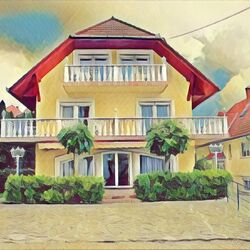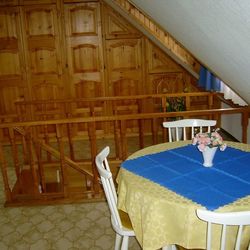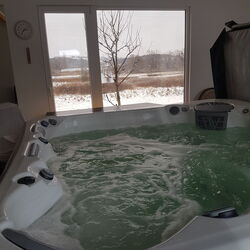

A symphony of flavors in every jar
Handcrafted mustard, grown in Hungary
In Hungary, only a handful of producers make mustard from locally grown seeds. Osgyán Mustard is special because its key ingredient — mustard seed — comes from Hungarian soil.
But it’s not just about the origin. Osgyán László’s small-batch mustards offer more than twenty unique flavor combinations, blending bold creativity with the soul of Hungarian cuisine. If you love trying new, exciting flavors, these small jars of golden goodness are made for you.
A new beginning — One mustard at a time
László began his mustard journey after leaving a career in pharmaceutical development. Seeking to break free from routine, he turned a long-time passion into his life’s work. Inspired by French, English, German, and Transylvanian mustards, he studied recipes from Roman times to Jamie Oliver, mixing tradition with his own creative twist. This fusion became the signature taste of Osgyán Mustard.
Every mustard is unique
Each variety has its own carefully developed recipe and process. Whether spicy or mild, every mustard starts with the same three ingredients: mustard seeds, vinegar, and 100% grape juice. László grinds the mustard seeds fresh for every batch. Flavors are added during cooking, not after, ensuring rich, integrated aromas.
Precise temperature control is key: spicy mustards are handled differently than milder ones to perfect the balance of heat and flavor.
Local ingredients, honest taste
Osgyán Mustard contains no preservatives, artificial colors, or flavor enhancers. Natural ingredients are non-negotiable. László sources pears, onions, horseradish, and pumpkins from local Zala County farmers whenever possible.
Some specialty ingredients, like anchovies, are imported but chosen with strict quality standards. Part of the mustard seed supply comes from László’s own fields in Szolnok, Eastern Hungary — the perfect environment for growing mustard. He uses a traditional Hungarian yellow mustard variety for an authentic taste.
Product highlights
Osgyán Mustard – Over 20 flavors to explore
The collection now includes more than twenty flavors, with some staples available year-round and others appearing seasonally. Best-sellers include caramelized onion, parmesan, chili, whiskey, and fig mustards.
Autumn brings pumpkin mustard, while Christmas features festive blends like ginger-cardamom or star anise. You’ll also find gluten-free, lactose-free, and sugar-free options — with clear, transparent labeling.
While László grows his own mustard seeds in Szolnok, other ingredients like pears and onions are sourced locally. The 100% grape juice, a key element of his recipes, comes from Dobosi Winery in Szentantalfa. Osgyán Mustard isn’t just a condiment — it’s a culinary experience. Enjoy it on meats, cheeses, or simply on fresh bread.
Where to buy
- Hévíz Farmers’ Market
More information & Contact:
- Website
- Phone: +36 30 912 5541
About 10,000 years ago, rapid climate warming triggered a cascade of natural responses: torrential floods, landslides, and intense rock weathering. The landscape we walk on today was not shaped over mere centuries, but by the dramatic forces of climate and water, working together. Did you know that the Zala Valley floor is made up of sediments deposited by a kind of "river of time"? Discover how the Earth’s surface became one of the most sensitive indicators of climate change. We often associate climate change with contemporary issues, but Earth’s climate has shifted many times throughout its history — sometimes quite rapidly. Within large-scale climatic cycles, alternating periods of warming and cooling have long been part of the planet’s natural rhythm. A change in climate sets off a chain reaction of environmental processes. It’s not just animals and plants that respond — so does the landscape itself. Around 10,000 years ago, as the climate warmed significantly, rainfall became more intense. More rain meant more erosion: stormwater began washing away sediment from hills and valleys into riverbeds. The rivers, now carrying more water and more sediment, flooded more often and spread these materials across the landscape. This had a major impact on topography: the land surface became more fragmented and dynamic. Warming temperatures also sped up chemical and physical weathering, breaking down bedrock and helping fertile soil layers to develop. Today, in many areas of the region, the lower slopes and valley edges are coated with sediment — debris washed down from higher ground, largely within the last 10,000–20,000 years. In the Zala Valley, for instance, these deposits have spread so far that they now reach the center of the valley floor. The original bedrock source of these sediments varies: in Zala, it’s typically Pannonian sand (Somló Formation), while in the Keszthely Hills, marine-origin carbonates dominate — mostly dolomite, with some limestone. These sediments now appear as fine gravel, pebbles, or coarse sand, quietly recording the environmental changes of the recent past.
Climate Change: Not Just a Modern Phenomenon
When Climate Changes, Everything Reacts
Shaping the Terrain
In short, natural geological processes that had long been underway suddenly accelerated — and reshaped the surface of the land.Young Sediments at the Base of the Slopes













